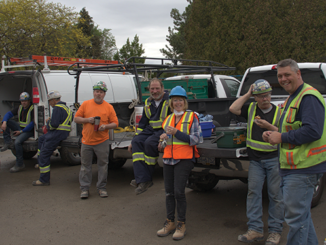
By Jordan Whitehouse
The next decade likely won’t be like the last. After about 20 years of solid growth that saw the doubling of Canada’s construction workforce, one quarter of a million people are now expected to retire from the industry by 2027. And while construction activity is slowing slightly overall, that’s still too many retirements to keep up with demand, says Bob Blakely, Canadian operating officer at Canada’s Building Trades Unions (CBTU).
“We have to understand that for every person that we’re going to graduate through the trades training system, we have to get slightly more than one extra person to start,” he says.
Over the next few years, a significant number of them will continue to head to Ontario and British Columbia, where growth is still peaking and where in BC alone the need for non-residential workers may increase by 25 per cent. In the east, though, demand will likely weaken, especially in Newfoundland and Labrador, which could see employment contract a further 20 per cent until 2024. Resource-driven Alberta is on shaky ground, too.
Despite the approach of a plateau, the industry won’t be contracting by 250,000 jobs. And finding the people to keep up with demand is going to take some innovation, especially when looking for science, engineering, technology, and math (STEM) workers, says Mary Van Buren, president of the Canadian Construction Association (CCA). “STEM workers are in increasing demand, but finding talent is a challenge because construction is not always seen as technology-forward.”
This is one reason organizations like the CCA and the industry in general are trying to widen their typical demographic target pool to better include women and Indigenous peoples. The CCA, for instance, released an Indigenous Engagement Guide in 2016 to help the industry engage more effectively with Indigenous companies and communities in Canada. More recently, the group has asked the federal government for 1,000 co-op placements in STEM fields that target women, Indigenous peoples, and new Canadians.
“We believe that if they have a taste of construction, then they’ll see the connection that they can have to Canada’s infrastructure,” says Van Buren. “These are tangible things that people can see, touch. But they need to be exposed to it, because it’s not top of mind.”
There is also going to have to be a culture change if the industry is going to attract – and retain – more women in particular, says Blakely. “You talk to people in the C-suite, and they will tell you that their places of businesses are proper, respectful workplaces. You talk to the middle managers, they don’t say much, just look at their feet. But if you talk to the bright young women who just started working there, they’re going to tell you that it isn’t quite the caring and sharing workplace that the people in C-suite think it is. So how we handle that piece is incredibly important.”
That culture change will have to extend to the millennial generation as a whole, agree Blakely and Van Buren, a generation that’s just starting to take on more leadership roles. Millennials tend to bring a collaborative style to the workplace and they demand respect in that workplace. “When I was an apprentice, it was okay to train by fear, to train by being mean to people, to train by ridicule and by sarcasm, to learn by failure,” says Blakely. “The idea was that this was the way that we get rid of the weak ones, the ones who weren’t going to cut it. Well, that was a lie. We got rid of the smart ones, in some cases. We can’t afford to do that anymore.”
They also can’t afford to let investor confidence continue to slip, which has been due, in part, to an unfavourable tax climate relative to the US and the ongoing trade wars, says Van Buren. That’s why, in November, the CCA said it was happy with the federal government’s fall economic update, which included commitments about prompter payment, accelerated depreciation, support for attracting under-represented segments into construction, and increased funding for infrastructure and innovation.
That innovation piece is really important, says Van Buren. “The industry is not as productive as other leading countries, and so the government’s announcement of adding more funding [$800 million] to the Strategic Innovation Fund is good news. We’ll definitely be looking to access some of that.”
No doubt a big part of that innovation will happen in big data, adds Van Buren. As technology gets further embedded and connected in our cities, all of that collected information could be very powerful to people. “Privacy is an issue, of course, but people may be will be willing to exchange some data in order to get a benefit, such as when the next train will arrive. So it’s going to be a whole new area of interest in how we manage all of that big data that’s going to be collected from our infrastructure.”
Which brings us back to that need to attract more workers to those STEM positions, in particular, and to the construction industry in general. It’s an issue that continues to be top of mind across the country and across the industry. It’s still unclear how it will all play out.
“The baby boom generation has been building Canada for the last 50 years, and though it’s as much a surprise to them as anybody else, they’re retiring,” says Blakely. Simply put: “We have to find some way to incorporate a quarter of a million people.” •



